Are you a Quiet Speculation member?
If not, now is a perfect time to join up! Our powerful tools, breaking-news analysis, and exclusive Discord channel will make sure you stay up to date and ahead of the curve.
I've had a theory for a while about the supposed health of Modern. Diversity is a big talking point for people who want to play Modern or Legacy over Standard, and I'm not sure it's quite as diverse as people want to think. It's diverse in the sense that a lot of people play a lot of different decks, but I'm not entirely sure how much of it is by choice. The relative expense of Modern and difficulty of switching decks causes a lot of people to hone their talent with one deck rather than switch to the perceived best deck. I think this is a big part of the reason why Modern and Legacy look more diverse than Standard.

The definition of a truly diverse format varies from person to person. For some it means you can play literally anything you want and still win with it, while others will content themselves with the presence of a deck for every play style. A lot of people say Standard isn't diverse because two decks make up a large portion of the top performing decks. Does that mean that other decks aren't good, or that people don't want to put the time in to make them good?
[wp_ad_camp_1]
Diversity and Cost
Maybe it means that decks are pretty inexpensive and that it's relatively easy to change to the perceived "best deck." Taking a quick look at the 5-0 competitive Standard leagues on MTGO, UW Flash finished 5-0 in approximately one to three of the 10 slots for the past two weeks. 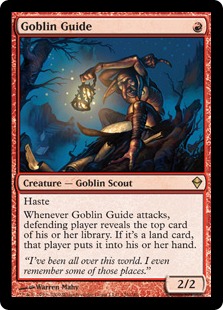 For Modern, almost every Competitive League has exactly one Burn deck that goes 5-0.
For Modern, almost every Competitive League has exactly one Burn deck that goes 5-0.
Does that mean that Modern is diverse and Standard isn't? I'm not really sure. But assuming we do consider the number of distinctly different decks as a sign of a healthy metagame, then is this diversity in Modern a product of the larger cardpool, or simply because it's really hard to switch decks?
I think the latter factor is far more important than people have generally accepted. Today I'll explain what obstacles are in place that prevent Modern players from switching decks, and how each might be affecting the metagame overall.
Cheap cards promote an easy switch
When the best decks in Standard were price behemoths with 10-12 fetchlands and 4 Jaces, Standard was pretty diverse. Most people couldn't afford to play decks that had all of those expensive cards so you saw a lot more Siege Rhino midrange decks.  With good mana, sometimes it looked like all of the decks were the same, but the reality of that format was you could play whatever you want. Sometimes you played against a Kalitas, Siege Rhino, Crackling Doom deck. Sometimes it was a Mantis Rider, Kolaghan's Command, Jace deck.
With good mana, sometimes it looked like all of the decks were the same, but the reality of that format was you could play whatever you want. Sometimes you played against a Kalitas, Siege Rhino, Crackling Doom deck. Sometimes it was a Mantis Rider, Kolaghan's Command, Jace deck.
Modern is seeing some of the same trends. You want to bring Bogles to a Grand Prix? You can probably win a ton of matches and feel like the deck is really good. Does that mean that Bogles is actually a good deck choice? It depends on what people are playing. If you get matched against Lantern Control and Sun and Moon decks early, you could be dropping before lunch. I don't usually consider decks that have such a hard time beating certain obscure cards "playable." Many people will disagree with that assessment—but there are others who do agree but continue to play decks with these weaknesses anyway. Why do they do it?
It's really hard to switch to the best deck in Modern
Ultimately it comes down to cost. Most decks in Modern have almost no overlap in cards. If you're playing Affinity and think that Jund is the best deck in Modern, how much does it cost for you to switch decks? You're basically forced to purchase the entire deck and learn all of the Jund matchups from scratch. The financial and mental cost of switching decks is so much for some players that they simply refuse to do it.
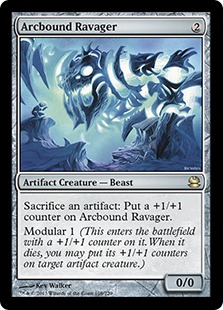 As Modern card prices drop, the metagame seems to get more focused. We can see the effect pretty easily on Magic Online. The Modern metagame changes quickly online and focuses so much more than it does in paper. A big reason for this is that the amount of money you lose for buylisting cards is so much smaller. For example, as of writing the buylist price of an MTGO Arcbound Ravager on Cardhoarder is 6.89 tickets (tickets are worth approximately $1). The sell price is 8.08 tickets. This makes a spread (or what you'd lose by selling them at buylist) of 15%. The spread on paper copies is 37% (assuming buylist of $24 and retail price of $38). So the opportunity cost just for selling and repurchasing a Ravager is more than double in paper. This differential is pretty typical for format staples.
As Modern card prices drop, the metagame seems to get more focused. We can see the effect pretty easily on Magic Online. The Modern metagame changes quickly online and focuses so much more than it does in paper. A big reason for this is that the amount of money you lose for buylisting cards is so much smaller. For example, as of writing the buylist price of an MTGO Arcbound Ravager on Cardhoarder is 6.89 tickets (tickets are worth approximately $1). The sell price is 8.08 tickets. This makes a spread (or what you'd lose by selling them at buylist) of 15%. The spread on paper copies is 37% (assuming buylist of $24 and retail price of $38). So the opportunity cost just for selling and repurchasing a Ravager is more than double in paper. This differential is pretty typical for format staples.
This may be one of the main reasons why people just "play their deck" rather than try to figure out a way to buy a better one. MTGO cards are also just a lot cheaper by virtue of constant reprints via flashback drafts, and a higher volume of drafting in general. You know one of the biggest symptoms of easier access to cards? Entire decks can just fall off the MTGO radar. You might find some 8-Rack enthusiast practicing on MTGO once in a while, but you're more likely to play against five Burn opponents in a row.
The cost of learning
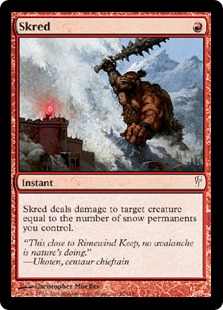 When there are fewer decks to test against it's definitely a lot less mentally taxing to learn to play a new deck efficiently. I've been playing Burn for close to three years. I still haven't played every matchup in Modern yet, but you learn a lot from playing similar decks. I'm pretty sure the only time I've played against a Skred deck was piloting Twin against Jeskai Skred. Does that mean I won't be able to adapt and win a match against Skred Red? No, my familiarity with how Burn sideboards in general should be enough to figure it out. I'll obviously bring in Kor Firewalkers if I have them, and ways to kill artifacts, since I assume some number of Ensnaring Bridges or Dragon's Claws are in their deck. But past that, I don't think I need to play the matchup to know how to win.
When there are fewer decks to test against it's definitely a lot less mentally taxing to learn to play a new deck efficiently. I've been playing Burn for close to three years. I still haven't played every matchup in Modern yet, but you learn a lot from playing similar decks. I'm pretty sure the only time I've played against a Skred deck was piloting Twin against Jeskai Skred. Does that mean I won't be able to adapt and win a match against Skred Red? No, my familiarity with how Burn sideboards in general should be enough to figure it out. I'll obviously bring in Kor Firewalkers if I have them, and ways to kill artifacts, since I assume some number of Ensnaring Bridges or Dragon's Claws are in their deck. But past that, I don't think I need to play the matchup to know how to win.
On the other hand, I've been playing Dredge casually for maybe a month. I'm not sure if I could find the correct configuration of cards to win sideboard games. Does that mean that I can't win them? No, but it is definitely a cost that I would pay if I were to switch decks. With an unprepared metagame, Dredge is likely my choice for the best deck in the format. But I'm not going to play it at the RPTQ because I know I don't have the experience necessary to play it at a level I'm comfortable with.
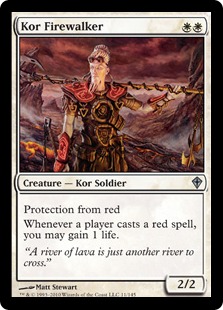 Has any of this run through your mind too? I have to believe I've never had this experience with Standard because the reality of the situation is the smaller card pool is just easier to learn. Even when there are tons of different decks and configurations, I can figure out a way to win in any situation. There are just too many situations that could come up in Modern that require prior experience to navigate expertly. The amount of investment required to learn a new archetype is another thing that keeps players from adopting the best strategies. Maybe a player thinks that Lantern Control is better than their current Affinity deck (and they even have some expensive overlap in staple cards) but they won't make the change because they don't believe they know the matches well enough.
Has any of this run through your mind too? I have to believe I've never had this experience with Standard because the reality of the situation is the smaller card pool is just easier to learn. Even when there are tons of different decks and configurations, I can figure out a way to win in any situation. There are just too many situations that could come up in Modern that require prior experience to navigate expertly. The amount of investment required to learn a new archetype is another thing that keeps players from adopting the best strategies. Maybe a player thinks that Lantern Control is better than their current Affinity deck (and they even have some expensive overlap in staple cards) but they won't make the change because they don't believe they know the matches well enough.
What Can Modern Masters Do for Diversity?
I've already explained the two major barriers to switching decks (money and time)—what happens if one of them is almost entirely eliminated? Reprints bring down the cost of decks pretty significantly (usually). What happens when decks get cheap enough that players can own more than one without feeling bad? I think we are going to see a big contraction in the number of Tier 3 and lower decks and a larger percentage of the meta will become Tier 1 decks.
Is that bad? Maybe, but it will start to make Modern look a lot more like Standard than Legacy at some point. As the number of decks people play decreases, the number of matchups you need to prepare for also decreases. The reality of lower price of entry into Modern is that there will just be fewer decks that people are willing to play. When players weigh the pros and cons of playing certain decks, there is definitely a lot of thought given to the cost of the deck.
Going Forward
We've seen a pretty big downward trend in the price of a lot of Modern cards. Some of it is anticipation of a reprint (like Snapcaster Mage) and some of it is just decks falling out of favor. At some point the demand for these cards will be so low, because of the perceived cost of the deck, that the bottoms will fall out on some of them. Tarmogoyf is a status symbol in Modern. It has fallen $10 in the last month after a year of decreasing price. 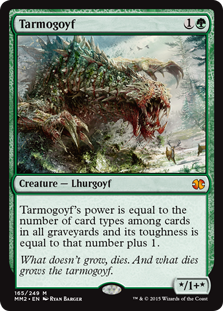 While it's the end of the year and prices are likely to sag, an 8% drop on a Modern staple in one month is significant. If this begins to happen to most other staples, I think we'll begin to see a shrink in Modern diversity.
While it's the end of the year and prices are likely to sag, an 8% drop on a Modern staple in one month is significant. If this begins to happen to most other staples, I think we'll begin to see a shrink in Modern diversity.
Modern is the most successful and most played format in Magic right now and that likely won't change. There's an even split of Star City Games Opens (between Modern and Standard) in the first half of next year, but I would be extremely surprised if Modern didn't continue to grow and overtake Standard. There is an obvious draw to Modern due to its low long-term costs and increasingly lower barrier to entry. Years of reprints and bans have brought the format to a place where almost anyone can buy in.
I'm worried that with the arrival of even more reprints in Modern Masters 2017 we will see people gravitate to a smaller number of decks. Reprints heavily incentivize people to purchase decks that receive them and I don't think we're too far off having more of the top decks become a larger part of the field as a result. I know it seems weird and counterintuitive, but I think the more reprints we see, the less people will start to enjoy Modern. The freshness and openness is largely influenced by the price. As we see prices go down, we may also see a decrease in the things that make Modern great.





I will say the narrow answers in modern also help create diversity.
For example the only reason mY waste not deck is anywhere near competitive is that it’s so difficult to interact with even post board.
People don’t run enchantment hate, especially wide ones (there’s 12 enchantments to hit)
And there’s not a good counter to one mana sorceries.
I think the very narrowness of the cards (no force of will, swords to plow shares, innocent blood, and even the discard is mostly narrow since thoughtseize isn’t popular) allows fringe decks to absolutely mop the floor with focused meta games.
Boggles is just a worse infect though.
Some decks are definitely due to pride and price.
as a quite successful rogue brewer (top 8 last two regionals with brews, and solid gp results with brews) I will say that often the “best” decks are not actually as good as people think.
Usually they are decks that have few feel bad moments, and are flexible.
I almost never think jund is the best deck. However a lot of very dedicated and skilled players pilot it and have for many years. I think it’s WHO chooses these decks that makes them seem so good.
People who want to win at all costs will look at what won, and they will throw themselves into the mission for success. This is actually a compliment to them. Some might take it as “damn netdeckers” and it’s not that.
What it means is you have a disproportionately large number of skilled players on these decks.
If you see someone trying to pilot a sultai control deck what are the odds they are a tier 1 competitive level player? Much lower than a jund player.
I think it’s a self fulfilling prophecy.
Also it’s really hard to analyze what will beat the current meta the best. Tom Ross is a good example of that mindset though.
Speaking of diversity, where the heck is the metagame breakdown? We’re still seeing SEPTEMBER.
Yes please. I love how everyone here does the meta game breakdown and I really appreciate it. If you could update it that would be awesome.
I will pass this feedback along. I’m not the one that does the metagame breakdown.
metagame breakdown pleeeease
I dont think the financial thing is an issue when it comes to deck selection. First, competitive players will pay for results. Second, most players I know have several tier one or two decks to choose from and that they can pilot reasonably well. Third, I dont think modern actually has massive swings in metagame and I think this site bears that out. Burn infect affinity jund have been t1 since forever. If you want a sure thing pick one of those. Bant eldrazi and dredge are newcomers – but relatively cheap to build if you want access to them (hierarch is the big cost I think? And if you had infect you already have them).
I dont know what the average standard player profile is but id think from a cost perspective the usual logic holds. Sure they can buy five competitive decks for the cost of two competitive modern decks, then watch all five crumble to dust at rotation and start over. Once you have your two tier modern decks you’re set, picking up a card here and a card there to adapt to new printings and banlist changes. So when you posit its easier to change decks in standard because its cheaper I think our usual narrative will check out – its cost effective for one or two rotations, and then you would have been farther ahead building good modern decks instead.
But fundamentally I think modern diversity is real and due largely to what the guy here posted about waste not. The cardpool is huge, decks cant stop everything, so if you can hit from an unusual angle you can be surprisingly competitive with weird builds. That and tier two and three decks are not generally that much worse than tier one. I dont have any different reaction to playing vs scapeshift, affinity or restore balance – they’re all valid decks with a modern calibre game plan. Nor do I think twice about playing tooth and nail or goblins when I could play jund infect or dredge – for a four round event the margins on the tier one options are not that large. Maybe in a ten round event.
“First, competitive players will pay for results.” This is, in my opinion, one of the fundamental flaws of this brilliant game. Just throwing that out there. Now to the rest:
I consider myself a highly competetive person. that’s not necessarily always a good thing, but it is how I am. I am competetive about everything I do. Sports, work, videogames, MTG. I wanna be good. I put huge amounts of time and effort into everything I do to sharpen my skills and always be up to par. I am a grinder. That being said, I refuse to spend 4 months’ rent on a stack of cardboard to play games. How long have I been staring at various Jund lists, thinking about the tweaks I could make and how much fun and how rewarding it would be to play them. Have dreamt about Abrupt Decaying a threatening Delver of Secrets, my opponent’s Mana Leaks rotting dead in their hand. Have imagined brilliantly sequencing my removal and threats to to watch my opponent sucumb to my pressure.
Then I look up the current price for a Tarmogoyf online and in paper. Then I sigh, slightly shaking my head. Then I load up MTGO and play a mediocre break-even-League with my budget-friendly Living End deck I have been playing for the last 3 years.
A very intriguing thesis. Perhaps Bolt is the most played card in Modern because it’s common? Maybe a Damnation reprint would actually affect the metagame?
I know that my finances haven’t been great in a long while, so I have worked around not being able to afford Damnation or EE and a variety of other things. When I traded some old stuff in I wasn’t using, Snapcasters were a much higher priority. I fully expect EE to get reprinted in MM17, Damnation….who the hell knows. Guarantee if they both get reprinted, I will enjoy the price drop and snag them while I can.
This is a really interesting article, thanks for writing it. I’m not sure I totally agree with your general point of the article (that modern will become less diverse as the cost of cards goes down), but I’m very interested to see what will happen. Somewhat less diverse perhaps, but i don’t think it will go as far as you seem to imply.
The reason I think it isn’t going to be as straightforward as your article seems to imply is that, unlike standard, the modern card pool is massively deep. I think that means that if the meta does shift toward fewer decks, smart players can meta-game fairly easily with so many options. I remember doing it when modern was dominated by pod and cruise delver. A good current example is Todd Steven’s sun and Moon deck, and the meta’s still relatively diverse at the moment. And as someone pointed out, Tom Ross already seems to do this at every event! And when big name players do this, others follow suit. Also, there’s folks out there like me who enjoy playing different (cheaper) decks to beat down all the tier 1 drones.